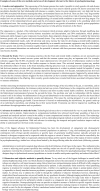Psychopharmacology: From serendipitous discoveries to rationale design, but what next?
- PMID: 32166162
- PMCID: PMC7058199
- DOI: 10.1177/2398212818812629
Psychopharmacology: From serendipitous discoveries to rationale design, but what next?
Abstract
Psychopharmacology really developed as a discipline from the mid-20th century with the discovery of a number of new classes of psychoactive drugs which could modify behaviour. These drugs were discovered as a consequence of clinical observations of patients, often being treated for other conditions. These serendipitous discoveries were the start of an era of drug development which has led to the antidepressants, antipsychotics, anxiolytics and mood stabilisers used today. Subsequent research focused on understanding why these drugs were effective, and used this information to develop a second generation of drugs that were more selective for their therapeutic targets, and therefore had reduced side effects and improved safety and tolerability. After a period of decline in new discoveries and withdrawal of the majority of the major pharmaceutical companies from active development programmes in psychiatry, new avenues are emerging fuelling renewed interest in this area.
Keywords: Psychiatry; animal models; antidepressants; antipsychotics; behaviour.
© The Author(s) 2018.
Conflict of interest statement
Declaration of conflicting interests: The author currently holds research grant funding from the MRC, BBSRC and Wellcome Trust. She has also received research funding from Boehringer Ingelheim, Eli Lilly, MSD, Pfizer and SmallPharma although these companies have not had any influence on the content of this article.
Figures




Similar articles
-
Pharmacogenomics, informatics, and individual drug therapy in psychiatry: past, present and future.J Psychopharmacol. 2006 Jul;20(4 Suppl):85-94. doi: 10.1177/1359786806066070. J Psychopharmacol. 2006. PMID: 16785276 Review.
-
History of Psychopharmacology.Annu Rev Clin Psychol. 2019 May 7;15:25-50. doi: 10.1146/annurev-clinpsy-050718-095514. Epub 2019 Feb 20. Annu Rev Clin Psychol. 2019. PMID: 30786241 Review.
-
The role of serendipity in the discovery of the clinical effects of psychotropic drugs: beyond of the myth.Actas Esp Psiquiatr. 2012 Jan-Feb;40(1):34-42. Epub 2012 Jan 1. Actas Esp Psiquiatr. 2012. PMID: 22344494 Review.
-
Anti-inflammatory drugs in the 21st century.Subcell Biochem. 2007;42:3-27. doi: 10.1007/1-4020-5688-5_1. Subcell Biochem. 2007. PMID: 17612044 Review.
-
Toward standardized usage of the word serendipity in the historiography of psychopharmacology.J Hist Neurosci. 2010 Jul;19(3):253-70. doi: 10.1080/09647040903188205. J Hist Neurosci. 2010. PMID: 20628954
Cited by
-
The Prescriber's Guide to the MAOI Diet-Thinking Through Tyramine Troubles.Psychopharmacol Bull. 2022 May 31;52(2):73-116. Psychopharmacol Bull. 2022. PMID: 35721816 Free PMC article. Review.
-
Metabolomic Investigation of Major Depressive Disorder Identifies a Potentially Causal Association With Polyunsaturated Fatty Acids.Biol Psychiatry. 2023 Oct 15;94(8):630-639. doi: 10.1016/j.biopsych.2023.01.027. Epub 2023 Feb 9. Biol Psychiatry. 2023. PMID: 36764567 Free PMC article.
-
Psychiatric genome-wide association study enrichment shows promise for future psychopharmaceutical discoveries.Commun Med (Lond). 2025 May 16;5(1):176. doi: 10.1038/s43856-025-00877-9. Commun Med (Lond). 2025. PMID: 40379965 Free PMC article.
-
From Computation to Clinic.Biol Psychiatry Glob Open Sci. 2022 Apr 2;3(3):319-328. doi: 10.1016/j.bpsgos.2022.03.011. eCollection 2023 Jul. Biol Psychiatry Glob Open Sci. 2022. PMID: 37519475 Free PMC article. Review.
-
Role of serendipity in the discovery of classical antidepressant drugs: Applying operational criteria and patterns of discovery.World J Psychiatry. 2022 Apr 19;12(4):588-602. doi: 10.5498/wjp.v12.i4.588. eCollection 2022 Apr 19. World J Psychiatry. 2022. PMID: 35582332 Free PMC article. Review.
References
-
- Andrews PW, Bharwani A, Lee KR, et al. (2015) Is serotonin an upper or a downer? The evolution of the serotonergic system and its role in depression and the antidepressant response. Neuroscience & Biobehavioral Reviews 51: 164–188. - PubMed
-
- Artigas F, Romero L, de Montigny C, et al. (1996) Acceleration of the effect of selected antidepressant drugs in major depression by 5-HT1A antagonists. Trends in Neurosciences 19(9): 378–383. - PubMed
-
- Axelrod J. (1972) Biogenic amines and their impact in psychiatry. Seminars in Psychiatry 4(3): 199–210. - PubMed
-
- Baldwin DS, Anderson IM, Nutt DJ, et al. (2014) Evidence-based pharmacological treatment of anxiety disorders, post-traumatic stress disorder and obsessive-compulsive disorder: A revision of the 2005 guidelines from the British Association for Psychopharmacology. Journal of Psychopharmacology 28(5): 403–439. - PubMed
Publication types
LinkOut - more resources
Full Text Sources

